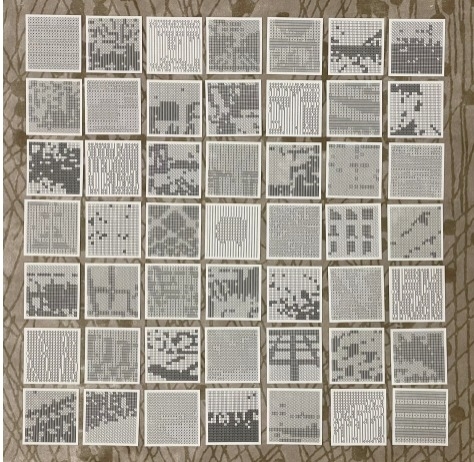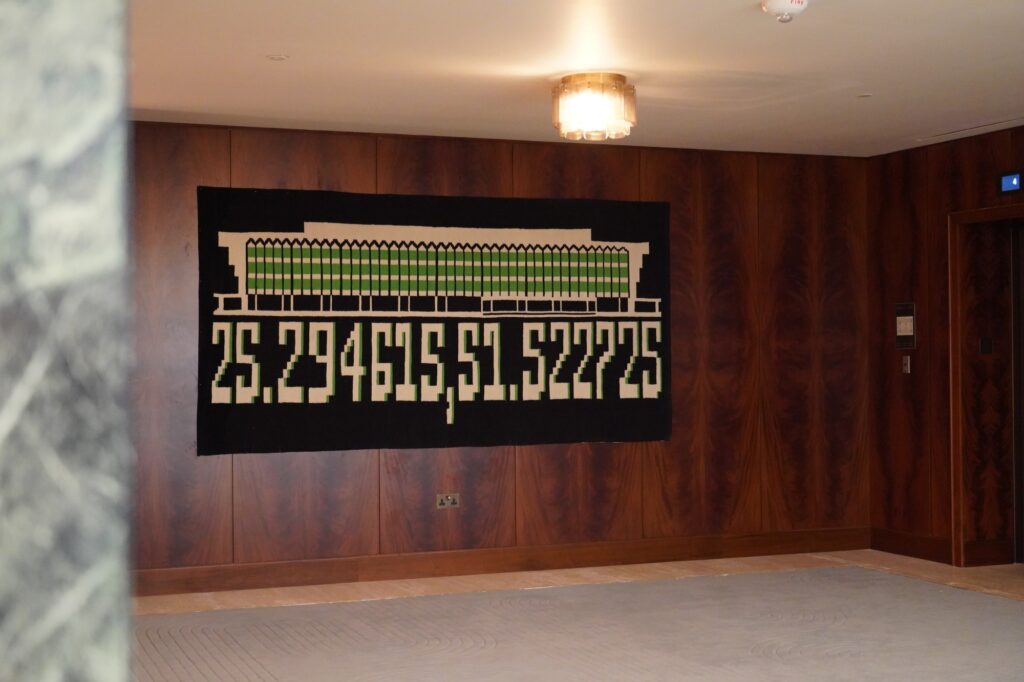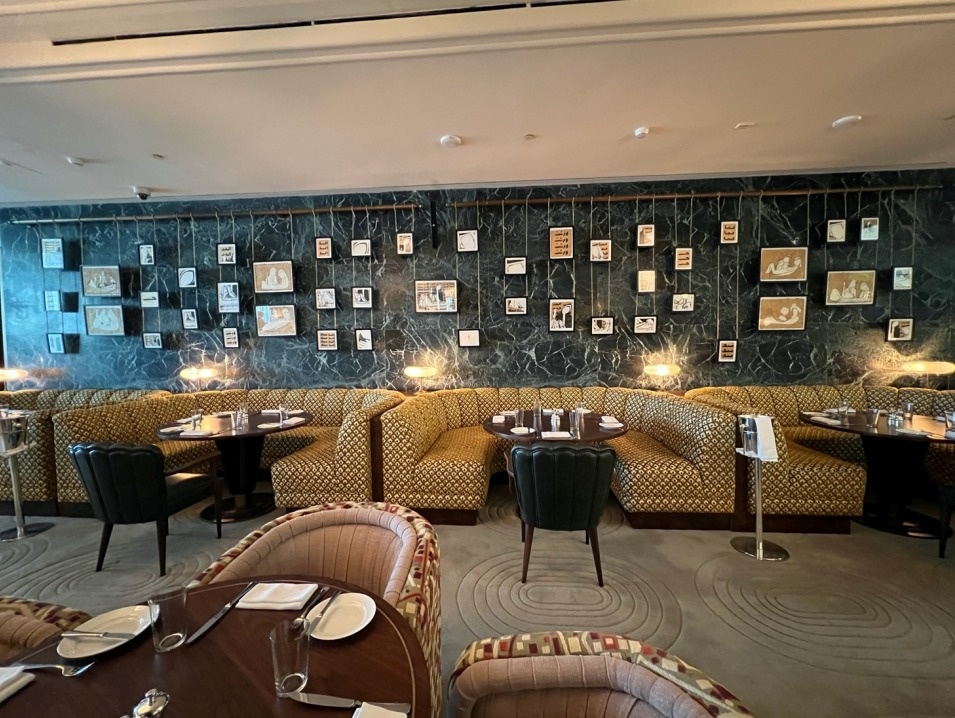The Ned Doha Features Over 350 Artworks of Contemporary Artists
The Ned Doha opened its doors quietly but its architectural brilliance did not take long to become the talk of the town. Soon its art collection gained attention for its museum-worthy collection. SCALE is equally enamoured by The Ned Doha by David Chipperfield, the Pritzker Award-winning-architect, as we are by the fact that it houses more than 350 works of art, with an extensive collection of original artworks created by close to 100 regional artists, with more than half based in Doha and nearly three quarters of whom are female. We talk to the curators behind this historic collection. By Sindhu Nair
The artworks inside The Ned Doha are impressive; not just in numbers but also for the philosophy and deliberation behind each of them. The Ned Doha’s artwork was commissioned to Mathqaf, a source of art and culture from West Asia and North Africa (WANA). Mathqaf is a research-based platform and a curatorial collective, that publishes, curates, and champions art. The force behind the institution is art historians-cum-curators Wadha Al-Aqeedi and Elina Sairanen, two passionate women who come together with a strong intent of championing art from the region.

“The Ned Doha Art Collection is regionally unique because it is one of the only places where visitors can see a permanent display of contemporary art from the region, including the work from the early career of museum-level artists.” Wadha Al-Aqeedi and Elina Sairanen. Photo: Ammar Al-Qamash.
SCALE conducted a Zoom interview with the two curators. We ask them about the theme followed to find out how the architecture of the Ned has created a seamless setting for art of such significance. When you have a building steeped in history (The Ned Doha is set in the Ministry of Interiors building which was refurbished by the current architects), it is safe to assume that any embellishments or art will take off from these striking settings.
“Our task was to create a permanent collection of contemporary art from Qatar and the region. We did not go with any thematic representation for the artwork because this in itself is a unique endeavour. There is no such project of this calibre; there is no permanent collection of this large capacity anywhere in the country. So, our task was to put the focus on the artwork and the artist,” says Elina Sairanen, who is a Ph.D. candidate in museology at the University of Leicester and focuses on the emergence of pan-Arab art collections and institutions.
But the architect and the interior decorator of hospitality spaces usually come with a pre-planned décor. So how did the two art curators adhere to this?

The Ned Doha is located in the former Ministry of Interior building, The Ned Doha includes Ned’s Club, a members’ club that gives access to spaces including a rooftop terrace, 90 bedrooms, a health club with spa, gym and 30m outdoor pool.
Wadha Al Aqeedi who is familiar with Doha and its art scene having worked at Mathaf: Arab Museum of Modern Art in Doha as an Assistant Curator for over four years says, “SoHo House, the sister concern of The Ned develops projects around the world, where they repurpose significant buildings with a rich history into The Club. With every interior fitting, they also curate the art in response to the building itself, to the community, the art scene of the location, etc. Soho House was the entity that entrusted us with this curation since they wanted The Ned Doha artworks to be true to its history.”
“The building was the departing point for us too but the underlying idea for this collection was to present a coherent and robust constellation of contemporary art from Qatar, West Asia, and North Africa (WANA). The selected artists, especially the ones based in Doha, represent the contemporary art scene happening right now in the region. The Ned Doha Art Collection is regionally unique because it is one of the only places where visitors can see a permanent display of contemporary art from the region, including the work from the early career of museum-level artists,” stresses Wadha.

Work of Hassan Manarash (Jordanian residing in Qatar) Everyday Rhythm / Shopping 2019 170 x 235 cm Acrylic on canvas
The 350 artworks curated by Mathqaf are acquired by the Ned. Explaining the process further, Elina says, “Our platform is not an art gallery but an educational platform. Soho House usually has an in-house art team who acquires art for their interior projects and for the Ned but this time, since they wanted someone who was cognizant of both the art in the region with local and regional expertise, they hired us to do the curation.”
The artwork features more than 350 works in a diverse array of media including textile, painting, and sculpture, and covers a wide range of themes including identity, history, culture, globalisation, and ecology. Many of the artists drew inspiration from the modernist building and its important location.
How did the curators start the process?

Work of Fatima Mohammed (Qatari), The Search, 2019 50 x 90 cm, Acrylic on canvas. Numerous works of Fatima can be found in the Ned, Doha.
“We started with the artist. We did not think about the artwork’s positioning, until much later. As art historians, we think about the collection’s coherence on its own. We obviously do not approach art in a decorative perspective but rather contemplate on who should be part of this collection,” explains Elina.
“Our process was different from any other projects. The Ned was under construction while we were curating and hence, we had complete freedom to curate the works,” says Wadha, “We had numerous site visits and we had also numerous art commissions where the artist created work in response to the history and the location of the space. And though we were guided by the works of artists rather than the physicality of the space, we also worked collaboratively with architects in terms of practicality in displaying artwork in certain occupied spaces and situations.”

Work of Aidha Badr (Egyptian-American), Her Cloth Was Cut From Heaven, She Wished To Be Me And I Wished To Be Her, 2021, 185 x150 cm, Oil on canvas.
Commisioned Works
Of the total of 350 plus artworks, 60 were commissioned works and the artists were invited by the curators to immerse in the surroundings and to create works that were in response to the building as well as to the country. All of the private rooms had commissioned works, so this is first in history where artworks in the rooms are all in response to the surroundings.
The Ned Doha art collection brings together the work of 95 artists, 61 of whom are based in Doha, and around 51 artists who are Qatari. Of the total of 350 artworks, around 60 of them were commissioned works. Interestingly, the art collection grew to include the work of 70% female artists, and it happened quite organically.
“In our platform, we champion artists from the region. Here, we had artists from the Arabian Peninsula and from Iran, Afghanistan, Tunisia, and a French artist who worked in Kuwait in response to the Gulf conditions. All the artists we chose are practicing artists shaping the artistic scene of the region and can be seen as the guiding pillars of the contemporary art scene of the region,” says Wadha.

Work inspired by the architecture of the building; Hind Al Saad (Qatari), Encoded Architectural Structures, 2022 100 x 100 cm. Square Plotted Prints. Commissioned by Mathqaf for the Ned Doha
The former building of the Ministry of Interior is a modernist masterpiece, nesting in the heart of Doha. The architecture, with its grids, structures, nooks, waffle ceiling, and textures, was a very fitting inspiration for artists to respond to the architectural language of Doha through the prism of materiality, composition, and space. For instance, Qatari artist Hind Al Saad was commissioned to produce an artwork titled Encoded Architectural Structures. Through an intricate computing process, Al Saad used coding to reinterpret photographs that she captured to reveal the various architectural elements that make up the historic MOI building–showing its unique character.

Work by Maryam Al Homiad (Qatari). Doha ReModernism, 2022 150 x 300 cm, Hand-dyed wool, hand-knotted carpet Commissioned by Mathqaf for the Ned Doha.

 The art collection includes two textile works by Qatari artist Maryam Al-Homaid, a contemporary Qatari artist, who describes the process of working with Mathqaf as a deeply insightful artistic experience. The first one, Doha ReModernism, is a commissioned work that depicts the former MOI building with its geographical coordinates.
The art collection includes two textile works by Qatari artist Maryam Al-Homaid, a contemporary Qatari artist, who describes the process of working with Mathqaf as a deeply insightful artistic experience. The first one, Doha ReModernism, is a commissioned work that depicts the former MOI building with its geographical coordinates.
A handwoven textile that showcases the facade of the newly reconstructed building with its unique window-dominant facade highlighted in neon green threads. The carpet not only documents the facade of the building but also notes the coordinates as well. A unique set of numbers that indicates the location. “In a way this number had a significance to the original purpose of the Ministry of Interiors which gives ID numbers to buildings, thus glorifying the building’s history through its artwork,” says Wadha of this beautiful tapestry that has numerous connotations behind its creation.

Work by Maryam Al-Homaid (Qatari), Urban Intervals, 2013, 183 x 100 cm Hand-dyed wool, hand-knotted carpet.
The second work, Urban Intervals, was done in collaboration with Levi Hammett, where the artists focused on Doha’s overlooked architectural landmarks from the 1980s and 1990s, abstracting them into visual patterns.
The art collection boasts over 350 artworks, including 60 commissioned works. The team invited artists to work on specific themes but also encouraged them to create works that aligned with their artistic practice and preoccupations.

Work of Noof Al Naama (Qatari), We Are the Grandkids 2022, Variable dimensions, Ink and gold leaf paper Commissioned by Mathqaf for the Ned Doha
 Another interesting commissioned artwork is the work of Qatari artist Noof Al Naama titled We Are the Grandkids, which consists of 46 drawings. Through this work, the artist reinterprets her late grandfather’s, pioneering Qatari artist Jassim Zaini (1943-2012), painting Features of Qatar drawn by the grandkids of the pioneer artist (from ages 3 to 22 years) as a tribute and a symbol of continuing his artistic legacy. This artwork is featured in Mathaf and the collection at Ned is a recreation of this historic work. At the Ned, the 46 artworks hang on the main wall of Millie’s Grill, one of the restaurants within the Hotel.
Another interesting commissioned artwork is the work of Qatari artist Noof Al Naama titled We Are the Grandkids, which consists of 46 drawings. Through this work, the artist reinterprets her late grandfather’s, pioneering Qatari artist Jassim Zaini (1943-2012), painting Features of Qatar drawn by the grandkids of the pioneer artist (from ages 3 to 22 years) as a tribute and a symbol of continuing his artistic legacy. This artwork is featured in Mathaf and the collection at Ned is a recreation of this historic work. At the Ned, the 46 artworks hang on the main wall of Millie’s Grill, one of the restaurants within the Hotel.
As you enter the Hotel, you are greeted by two works of Qatari artists opposite each other, on the right side is pioneering artist Yousef Ahmed’s work and on your right is the work of contemporary artist Bouthayna Al Muftah, who represents the future of art in the country.
“It was important for us to have these two artists placed right at the entry; it signifies the enormity of the collection, from the pioneering artist to the new talents of the country,” says Wadha.

Work of Hashel Al Lamki (Emirati), Boulevard, 2022, 160 x 240 cm Oil, natural pigment, oil pastels, ink on cotton bedsheet.
While it is difficult for the curators to pick out the most important works on the Ned, Elina cannot help but point out the ones that are indicative of the art scene to come out from the region, like the commissioned works that have a rare story to narrate, of the place and the artists connections to it. She also touches on two works of art that put the focus on two upcoming artists, Emirati artist Hashel al Lamki and Hangama Amiri, Afghan-Canadian artist whose work is displayed at The Club, on the fourth floor of the Ned, which has exclusive access only to members.
“While these works are not accessible as the rest, they are brilliant works of art and we hope that they will become the future harbingers of the art history of the region,” she says.
Another artist whose work is revolutionary and is a ray of hope for the artistic scene of the region is Sophie Al Marri, whose work is just near the café next to the lobby at the Ned, and is representative of the works that will emerge from the region.
“We are happy that young artists have a space to showcase their art as part of a collection, within a more casual space which is equally beautiful on its own, because art can be enjoyed in spaces not as austere as a museum,” she says, and that is what the Ned is all about, a place to relax and enjoy the most contemporary collection from the region.
Images Courtesy The Ned Doha and Mathqaf



